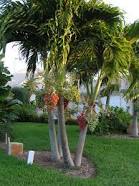ARECACEAE
Palm family
Acecaceae includes approximately 2oo genera of evergreen solitary or clustering trees or stemless shrubs, rarely climbers, from tropcical and mild temperate regions. The architecture of palms is elegant and diverse. Though unfamiliar to many, inflorescencess and fruit are often highly ornamental. Leaves are compound, some with pinnate leaflets arranged along a midrib and sometimes with an elongated petiole base that sheathes the top of the trunk. Other palms have palmately compound leaves, with the leaflets spreading fanlike and radiating from a disklike structure at the end of the petiole. Costapalmate leaves are also fan – shaped but somewhat folded lengthwise, the sides arching, with the bases congested on a short rachis. Fishtail palms are the only bipinnately leafed palms, with a branched rachis and wedge – shaped leaflets. Palm leaflets may be partially fused along their edgess or completely free, juvenile leaflets are often more fused than adults. Flowers are small. in many – flowered panicles. The inflorescence is subtended by a spathelike bract.
The apical meristem at the apex of the trunk or stalk is the only growing point. It cannot be cut bacck without killing the individual stem, making it very important to select palms of appropriate mature height. Palms are susceptible to a variety of diseases and pests. Lethal yellowing disease has devasstated sussceptible species where it occurs. Palms often develop nutritional deficiencies in alkaline soils and need supplemental micronutrients. Photos of the trunks and leaf scar patterns are provided here because they are often ornamental and excellent field marks that are easily observed at eye level. Palmswere photographed primarily at Faichild Tropical Garden and the Montgomery Botanical Center.
Adonidia
Adonidia includes a single species of solitary palm from the Philippines. Leaves are pinnate. Flowers are unisexual, with male and female flowers on the same tree. This popular palm was included in Veitchia for a long time but has now been returned to Adonidia because of a number of characteristics that differ from Veitchia. One biological distinction, unfortunately, is susceptibility to lethal yellowing disease. This palm bears fruit from fall to spring. It is called Christmas palm for the baublelike fruits that appear over many months, not just the Christmas season.
Manila palm, christmas palm
Synonym: Veitchia merrillii. Philippines. Solitary palm. 20-50ft, zones 10-11. Blooms intermittently in warm, wet months. Moderate moisture. Average to fertile, well – drained soil. Full sun to bright broken light. Flowers: unisexual, inflorescence stalk white, fruit plum – shaped, crimson – red, bracts 2, one inside the other,, short – lived, papery. Leaves: pinnate, arched, leaflets near the base in several ranks with long reins, becoming one – ranked toward the ends, held obliquely in a V, tips jagged, crownshaft long, gray – green. Stems: base spreading, leaf scar rings closely spaced or up to 2 in. apart depending on light exposure. A cold – sensitive, fast – growing, and somewhat salt – tolerant palm. Because it is highly susceptible to lethal yellowing disease, it is short lived in affected areas.


Deprecated: strpos(): Passing null to parameter #1 ($haystack) of type string is deprecated in /home/agriviek8Qv/agriviet.net/public_html/wp-includes/comment-template.php on line 2522